Before and after photos on dental restorations using composite resin fillings performed in our Cosmetic Dentistry office.
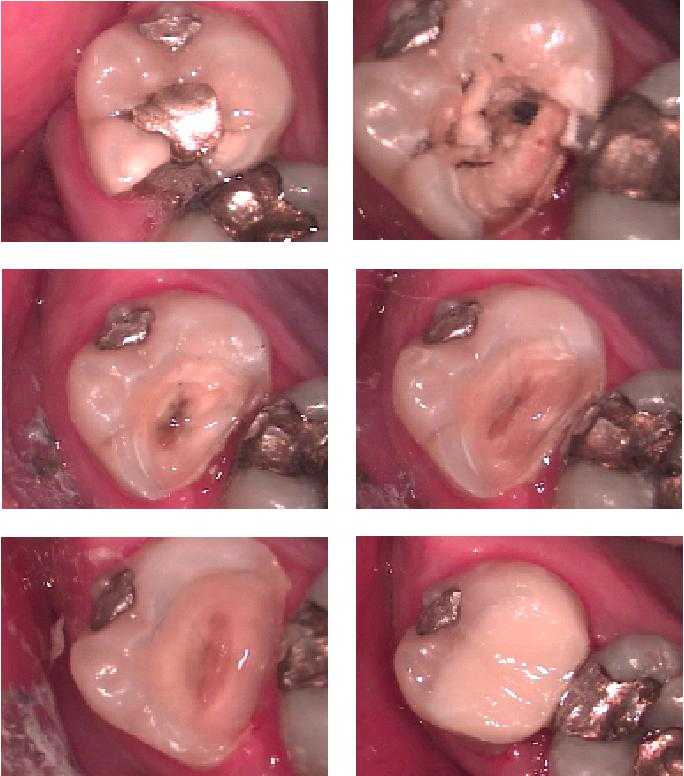
Teeth bonding a very deep and large cavity in an upper right second molar. This tooth will ideally need root canal therapy, post and crown with probable crown lengthening gum surgery. The patient wants to postpone this treatment if possible.

Decay – cavity – removal in a large cavity and a cosmetic dentistry bonding.
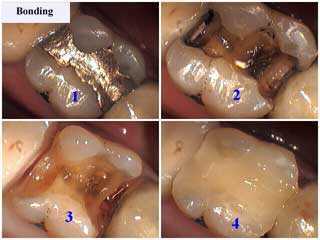
Tooth Bonding restoration technique. Changing silver fillings to tooth colored white fillings.
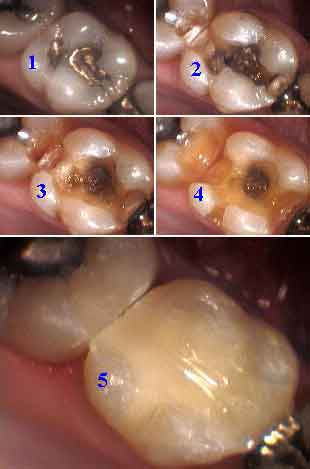
Dental Bonding Technique. After acid etching, apply All Bond 2 dentin primer to remove the smear layer. Then apply All Bond 2 dentin enamel bonding agent with dual cured catalyst. Bis-fil 2B self cured composite is next placed in the interproximal boxes and somewhat over the occlusal floor. It can be compressed into the interproximal boxes by condensing on preformed, already cured 2 mm wide balls of Herculite XRV bonding material. Herculite XRV bonding material is added on top. Light curing should occur for 60 seconds on each the occlusal, buccal and lingual surfaces. A metal matrix band with regular wood wedges work fine. Refine anatomy with a #8 round bur and finishing burs. Then use Fortify.
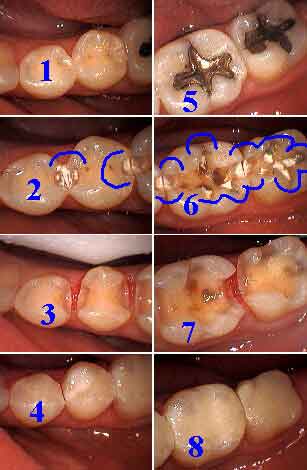
Treatment of teeth decalcification. This is frequently caused by oral ingestion of fruit juices and improper oral hygiene.
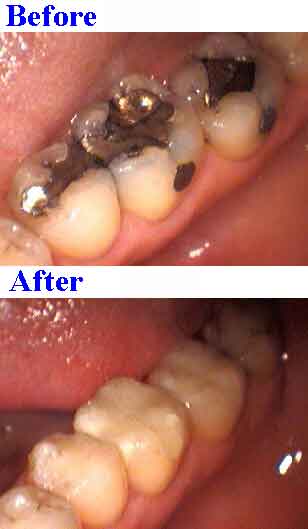
Cosmetic dentistry bonding changes silver fillings to match the white color of the teeth. Bonding and composite resin fillings have a similar meaning. Bonding technically refers to the glue used to hold the white tooth filling material inside or on the tooth.
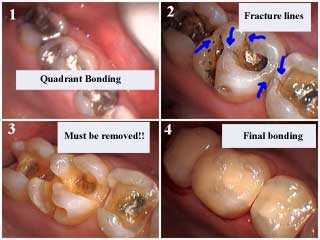
Cosmetic dental bonding white filling technique to treat old, decayed silver fillings.
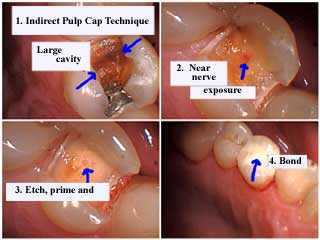
Dental bonding white filling in a very deep cavity. Note the cavity in the tooth and the near nerve exposure. This was an indirect pulp cap.
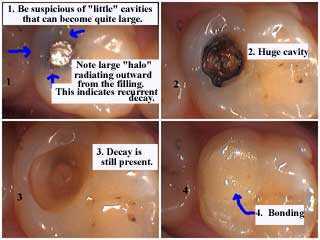
Deep tooth decay – cavity – under a small silver filling and repair with cosmetic dental bonding.
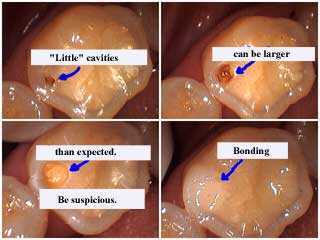
A dental cavity can be larger than expected when first looking at the tooth.

Bonding two upper premolars removes the silver fillings which show gray through the tooth enamel.
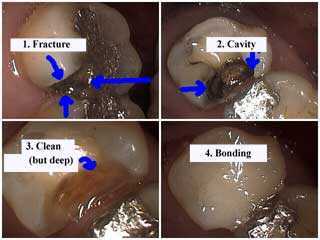
Dental bonding to treat a fractured silver filling.
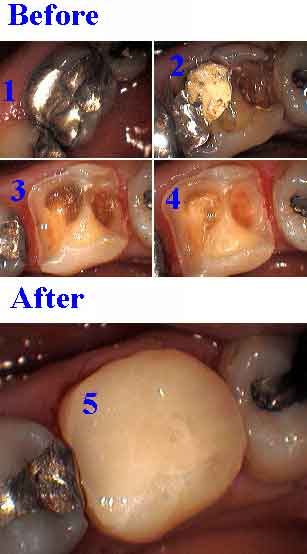
Cosmetic Tooth Bonding changes silver fillings to white. Bonding and composite resin fillings have a similar meaning. Bonding technically refers to the glue used to hold the white tooth filling material inside or on the tooth.
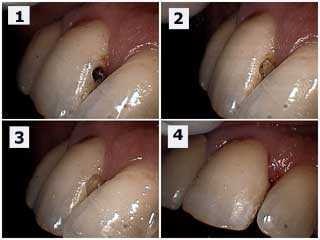
Decay (cavity) removal between two front teeth. 1) Decay noted. 2) Decay being removed. 3) Decay removed. 4) Bonded filling cannot be seen.
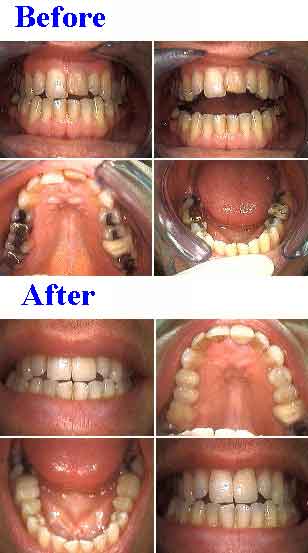
Porcelain crowns, teeth bonding and whitening – bleaching completed this smile makeover.
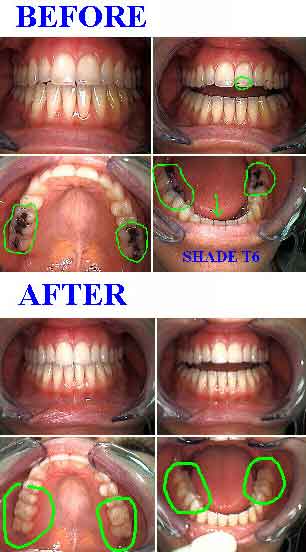
Teeth Bonding replace silver fillings with white bonded fillings. All ten fillings (top & bottom) replaced in ONE VISIT!

Dental Bonding following removal of decay under a silver filling.

Tooth Bonding changes this silver filling to a tooth-colored white filling.
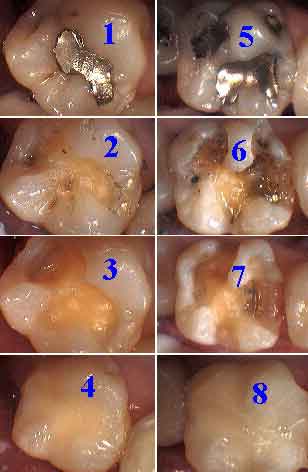
Cosmetic Teeth Bonding used to change silver fillings to white fillings in two different teeth.
Tooth #1: images 1-4
Tooth #2: images 5-8
Tooth #1: images 1-4
Tooth #2: images 5-8
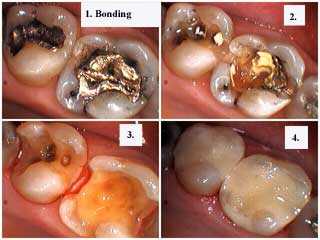
Replacing two large, decaying silver fillings with dental bonding material.
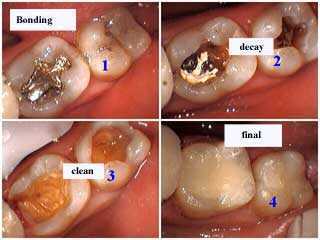
Dental bonding technique to remove a silver filling with a lot of tooth decay.

Aesthetic quadrant teeth bonding changes silver fillings to white fillings.

Upper reconstruction in a phobic patient. The patient was a pretty, 33 year-old female. Treatment included porcelain fused to metal crown & bridge, root canal therapy on all abutments, root tip extractions, and facial teeth bonding on both upper lateral incisors. The upper anterior root canal and crowns were first completed to show her how pretty her teeth could look and that it could be accomplished quickly and painlessly. Extractions of the hopeless teeth were all completed at one time and initiated early to allow time for healing before bridgework. Then root canal therapy was performed on the posterior abutments before their preparation for bridgework. The patient experienced minimal post-operative pain.
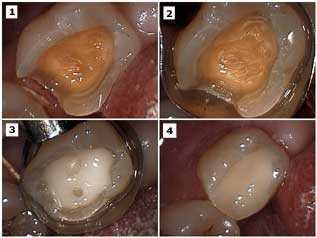
Final tooth preparation before placement of direct-bonding material in a lower molar. 1) – 2) Final tooth preparation. 3) Placement of chemically-cured flowable bonding material. Note the presence of several spheres of slightly different-colored bonding material within the flowable bonding material. These are spheres of light-cured bonding material (“bonding balls”) that are used to condense against. 4) The final tooth bonded restoration.
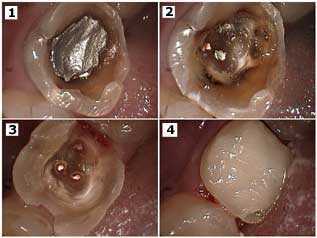
Treatment of a very decayed, root canaled molar with only a large tooth bonded restoration. 1) Neglected lower molar tooth that had an adequate root canal yet very decayed amalgam (silver) filling. 2) View of the extent of the decay after removal of the filling. 3) Decay removed. Note the gutta percha coming out of the three orifices. 4) The bonded restoration. The point here is that a tooth bonded restoration filling can be placed even when a crown is obviously indicated. The crown will be placed after the patient completes orthodontics.
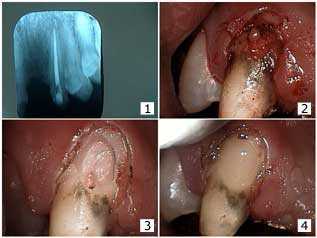
Bridge repair. The patient recently lost his job in telecommunications and could not afford replacement of the bridge. 1) X-ray after root canal therapy. The root canal itself did not seem subject to external resorption. 2) Gingivectomy with electrosurgery. Note the still unusual look of the facial decay. 3) Following decay removal. Note the communication to the gutta percha. 4) The tooth bonded restoration filling. Photo #2 of 3.
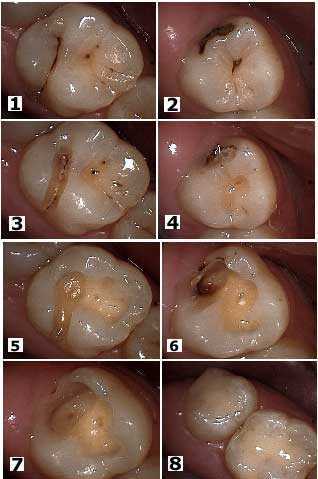
Cavity identification, cavity removal and bonded fillings in two upper molars. Image #’s 1, 3, 5 and 8 show the first molar; Image #’s 2, 4, 6, 7 and 8 show the second molar. Image #’s 1 and 3 show the initial cavity. Image #’s 3 – 7 show the steps in cavity removal. Image # 8 shows the final teeth bonded white fillings.